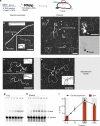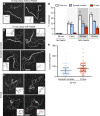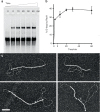In vitro role of Rad54 in Rad51-ssDNA filament-dependent homology search and synaptic complexes formation
- PMID: 31492866
- PMCID: PMC6731316
- DOI: 10.1038/s41467-019-12082-z
In vitro role of Rad54 in Rad51-ssDNA filament-dependent homology search and synaptic complexes formation
Abstract
Homologous recombination (HR) uses a homologous template to accurately repair DNA double-strand breaks and stalled replication forks to maintain genome stability. During homology search, Rad51 nucleoprotein filaments probe and interact with dsDNA, forming the synaptic complex that is stabilized on a homologous sequence. Strand intertwining leads to the formation of a displacement-loop (D-loop). In yeast, Rad54 is essential for HR in vivo and required for D-loop formation in vitro, but its exact role remains to be fully elucidated. Using electron microscopy to visualize the DNA-protein complexes, here we find that Rad54 is crucial for Rad51-mediated synaptic complex formation and homology search. The Rad54-K341R ATPase-deficient mutant protein promotes formation of synaptic complexes but not D-loops and leads to the accumulation of stable heterologous associations, suggesting that the Rad54 ATPase is involved in preventing non-productive intermediates. We propose that Rad51/Rad54 form a functional unit operating in homology search, synaptic complex and D-loop formation.
Conflict of interest statement
The authors declare no competing interests.
Figures






Similar articles
-
Rdh54/Tid1 inhibits Rad51-Rad54-mediated D-loop formation and limits D-loop length.Elife. 2020 Nov 13;9:e59112. doi: 10.7554/eLife.59112. Elife. 2020. PMID: 33185188 Free PMC article.
-
Rad54 functions as a heteroduplex DNA pump modulated by its DNA substrates and Rad51 during D loop formation.Mol Cell. 2014 Feb 6;53(3):420-32. doi: 10.1016/j.molcel.2013.12.027. Epub 2014 Jan 30. Mol Cell. 2014. PMID: 24486020 Free PMC article.
-
Rad54 protein stimulates heteroduplex DNA formation in the synaptic phase of DNA strand exchange via specific interactions with the presynaptic Rad51 nucleoprotein filament.J Mol Biol. 2001 Apr 13;307(5):1207-21. doi: 10.1006/jmbi.2001.4555. J Mol Biol. 2001. PMID: 11292336
-
Functions of the Snf2/Swi2 family Rad54 motor protein in homologous recombination.Biochim Biophys Acta. 2011 Sep;1809(9):509-23. doi: 10.1016/j.bbagrm.2011.06.006. Epub 2011 Jun 16. Biochim Biophys Acta. 2011. PMID: 21704205 Free PMC article. Review.
-
Discrete roles for Rad54 and Rdh54 during homologous recombination.Curr Opin Genet Dev. 2021 Dec;71:48-54. doi: 10.1016/j.gde.2021.06.013. Epub 2021 Jul 20. Curr Opin Genet Dev. 2021. PMID: 34293661 Review.
Cited by
-
The Inability to Disassemble Rad51 Nucleoprotein Filaments Leads to Aberrant Mitosis and Cell Death.Biomedicines. 2023 May 15;11(5):1450. doi: 10.3390/biomedicines11051450. Biomedicines. 2023. PMID: 37239121 Free PMC article.
-
Fission yeast Rad54 prevents intergenerational buildup of Rad51 aggregates in proliferating cells.Life Sci Alliance. 2025 Aug 18;8(11):e202503252. doi: 10.26508/lsa.202503252. Print 2025 Nov. Life Sci Alliance. 2025. PMID: 40825586 Free PMC article.
-
Beta HPV Deregulates Double-Strand Break Repair.Viruses. 2022 Apr 30;14(5):948. doi: 10.3390/v14050948. Viruses. 2022. PMID: 35632690 Free PMC article. Review.
-
Rdh54/Tid1 inhibits Rad51-Rad54-mediated D-loop formation and limits D-loop length.Elife. 2020 Nov 13;9:e59112. doi: 10.7554/eLife.59112. Elife. 2020. PMID: 33185188 Free PMC article.
-
Human RAD52 stimulates the RAD51-mediated homology search.Life Sci Alliance. 2023 Dec 11;7(3):e202201751. doi: 10.26508/lsa.202201751. Print 2024 Mar. Life Sci Alliance. 2023. PMID: 38081641 Free PMC article.
References
Publication types
MeSH terms
Substances
Grants and funding
LinkOut - more resources
Full Text Sources
Molecular Biology Databases
Research Materials

